Samsung Galaxy S2 Review
Samsung Galaxy S2
It's the most powerful smartphone on the planet, but is it the best?
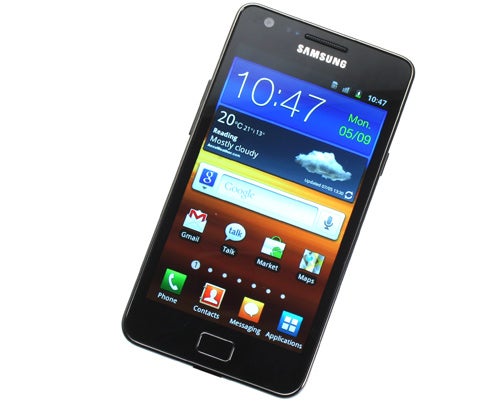
Verdict
Pros
- Incredibly fast
- Dazzling 4.3in screen
- Excellent video playback
- Web browser supports Flash
- Light for its size
Cons
- Too large for some
- Plastic build doesn't feel premium
- Poor call quality
Key Specifications
- Review Price: £477.00
- 1.2GHz dual core processor
- 4.3in Super AMOLED Plus display
- 8 megapixel camera
- Android 2.3 Operating System
Check out our video review of the Samsung Galaxy S2:
You wouldn’t guess the Galaxy S2 was packing all this heat from looks alone. At just 8.5mm thick it’s a true size zero of the smartphone world. That said, thickness is the only dimension where this phone does undercut the competition; when it comes to width and height, it’s larger than most. Indeed the 66.1mm width and 125.3mm height make this phone feel just a little unwieldy – you have to grip it with your fingertips rather than it sitting comfortably in the palm of your hand. It’s very much a personal preference thing but we did find this phone a little too big.
Samsung has thought about this usability issue though. Rather than making you stretch all the way to the top edge to lock and unlock the phone, you can unlock it using the central button on the front. Also, the power button is housed on the right edge where it falls more easily within reach – it is still a bit of a stretch though.
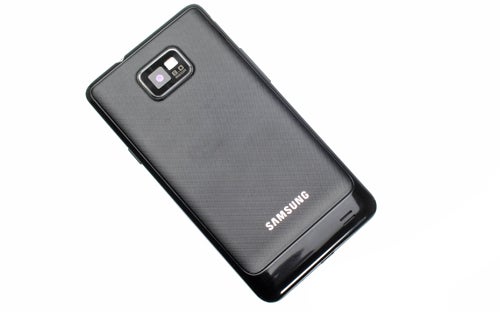
We have few complaints when it comes to styling, but here too are not particularly blown away. The front is clearly an homage to the iPhone 4 with a mostly seamless expanse of glass except for the earpiece grille and central button. It’s classy and minimalist, though doesn’t quite have the allure of the LG Optimus 2X, for instance, with its curved screen edges. Meanwhile the back is a mix of glossy black plastic and a finely chequered black plastic, which does a good job of hiding fingerprints and scratches but doesn’t feel all that great in the hand. The latter finish adorns the battery cover, which prizes off via a thumbnail notch on the left edge, and is alarmingly thin and flimsy.
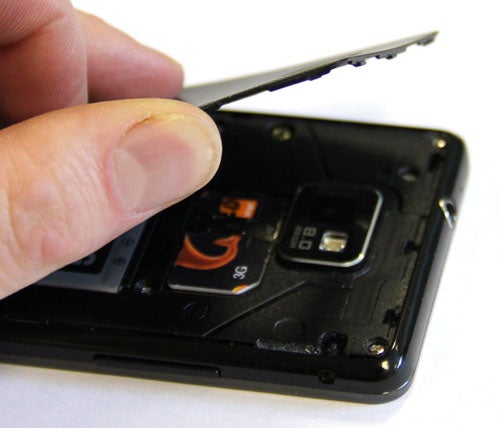
You don’t notice this when the back’s on, as the support plastic underneath keeps it held nice and firm, but take it off and it feels more like you’re peeling the top off a yoghurt pot than opening the back of a £500 phone. Indeed, with its thin profile, the whole phone feels a little delicate compared to the robustness of something like the iPhone 4. Certainly we’d be particularly paranoid of this phone coming a cropper if you accidentally sat on it.

Otherwise, we’re talking about a typically well equipped Android phone with a headphone jack on the top edge, a volume rocker on the left, microUSB on the bottom and microSD nestled next to the battery under its cover. You get 16GB or 32GB of storage onboard and can add up to 32GB via the memory slot. There is one further slip up, though. Quite simply, there’s no HDMI port. It’s not something that’s particularly useful for everyday use but being able to plug your phone into a TV is a neat way to view pictures or video. With the help of an adapter you can use the microUSB port for this purpose but these currently aren’t easily available.

Emerging from the blackness either side of the central Home button when the phone is activated are light-up touch sensitive controls for Back and Menu. They’re responsive and fall within easy reach.
The particular version of Android on show here is Android 2.3.3
Gingerbread, which isn’t quite the latest (2.3.4 adds video chat) but
the Galaxy S2 suffers little because of this, and an update should come
relatively soon. As usual, Samsung couldn’t resist giving the interface a
bit of a visual tweak.
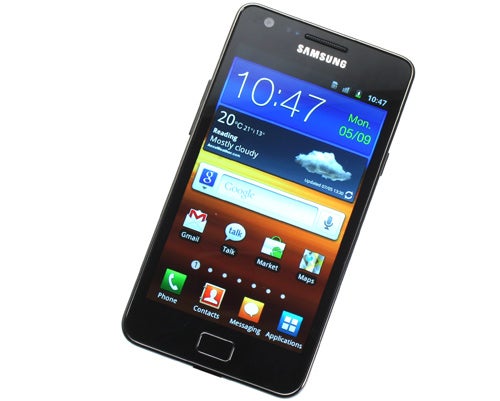
The
most obvious change is that the main desktop/homescreen (the one the
home button takes you to) is the left most one (as opposed to the middle
one) with six others available off to the right and none to the left.
If you swipe as though to access a screen to the left of the homescreen,
it just bounces off rather than looping through to the right-most one
as you’d expect.
This is downright annoying as it means you can
only access one other screen within one swipe of your finger, whereas if
you’re free to swipe to the left and right you can access two pages
within one swipe. It may sound very picky, and indeed if you tap the
tiny dots that run along the bottom of the screen you can access all the
homescreens in one motion, but it’s just such a silly little usability
failure. And one can’t help but think Samsung has done it simply to make
the phone look/feel more like an iPhone, without thinking about the
usability.
Another annoyance is the lock screen. Once you’ve
activated the screen with the touch of the central home button or side
power button you can unlock the phone by swiping the picture in whatever
direction you want. Great! Except because there’s no visual indicator
to tell you how far you need to swipe, it can take several goes for it
to successfully register that you’re trying to unlock the screen,
otherwise the picture simply snaps back into position.
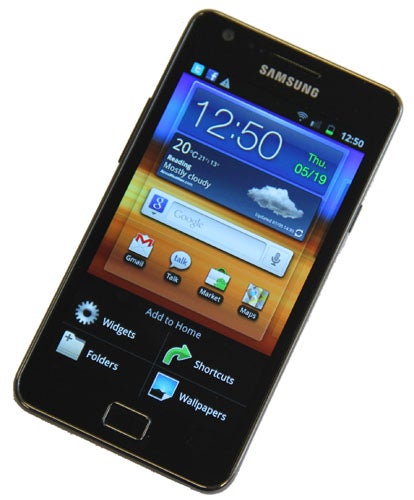
From
here on in, though, this phone is a breeze to navigate, and has a
particularly good homescreen manager. Just as with other Android
handsets, you can simply drag apps to and from the various homescreens
or add folders of apps and widgets to them. However, Samsung has upped
the usability by splitting the screen and having the homescreens
presented as shrunken versions of themselves in a carousel arrangement
at the top, making it easier to see where you want to place things. You
can also resize widgets using a simple grab-the-corner-and-drag method.
You can’t start an app folder by simply dragging one app on top of
another though, as on the iPhone and Sony Ericsson’s latest Android
phones.
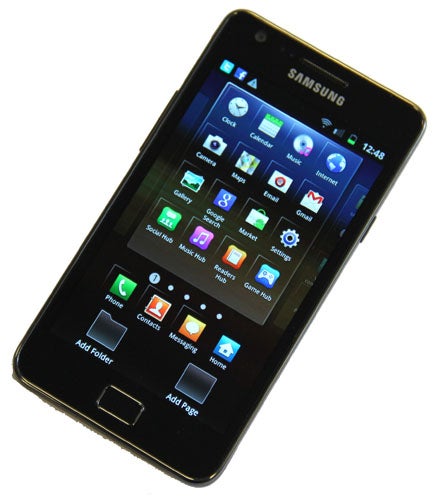
This
same visual style is also used to let you rearrange the apps in the
main menu (App Launcher). While this customisation is welcome, it’s
rather annoying that you can’t simply choose to have all your apps in
alphabetical order, as most Android users have become used to. After
all, with all those homescreens as well, having to organise the main
menu just means you have two things to keep on top of.
Also of
debatable benefit is the addition of ’tilt to zoom’. By holding two
fingers on screen and tilting the phone back and forth you can zoom in
an out of the usual selection of apps such as the picture viewer and web
browser. If ever there was a feature to represent the word ‘gimmick’ in
the OED, this could well be it. Thankfully you’re under no obligation
to use it.
Samsung has become known for its AMOLED screens, which are famous for having incredibly vivid colours, pure blacks, and essentially infinite viewing angles. However, we’ve always had a problem with the majority that we’ve seen as they tended to look rather grainy due to their pentile sub-pixel arrangement – particularly the Super AMOLED model used on the original Samsung Galaxy S. Thankfully Samsung has fixed this with its latest generation, Super AMOLED Plus displays, as sported by the Galaxy S2. The result is rather stunning.
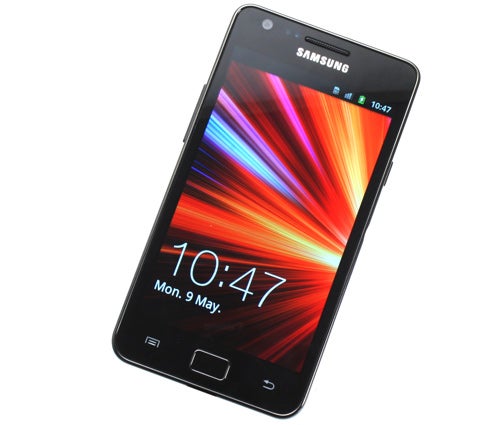
Colours simply leap out at you in a quite mesmeric way while blacks never look grey but truly tarry, and most importantly it looks nice and sharp with none of the old graininess. What’s more, the display has a particular quality of feeling, as if it’s right on the surface you’re touching, not someway behind layers of glass. This only helps it look more vibrant. Viewing angles have also improved – some older AMOLEDs could suffer with a strong blue shift when viewed from an angle. While this is still present to an extent on this model the effect isn’t half as bad. That said, there is a slight blueish tone to the overall display. In general use you don’t really notice it but certainly if you compare a white piece of paper to what the Galaxy S2 reports as being white, the difference is obvious. Clearly this isn’t the best phone to edit photos on!
It’s also worth noting that with a resolution of 480 x 800 pixels, the 4.3in display doesn’t actually pack in as much detail as it perhaps could. After all, the iPhone 4’s display has 960 x 640 pixels in just a 3.5in panel. It seldom looks out-and-out blocky or blurry but you do sometimes notice jagged edges to, in particular, black text on a white background.
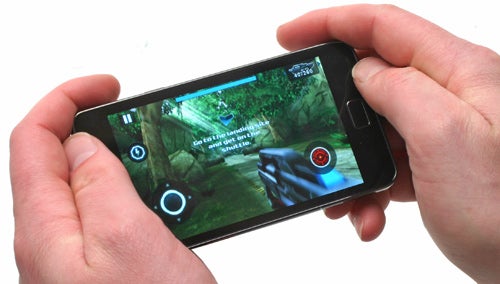
Originally the S2 was to launch with a dual 1GHz CPU but in a brazen act of one-upmanship Samsung took a little extra time to boost the processor to a competition-blasting 1.2GHz. The result is a phone that is noticeably the fastest going – it simply flies along. Every now and then there’s the slightest of pauses as you navigate the interface but most of the time it will be you who is slowing things down, not the phone. From tapping out texts through gliding round the internet to flinging agitated aves around, this phone never has a hiccup.
As ever the benefits of the dual-core processor are not totally obvious, but clearly multi-core is the way forward and the S2 is leading the pack, with an extra 200MHz and the fast graphics hardware over some rivals.
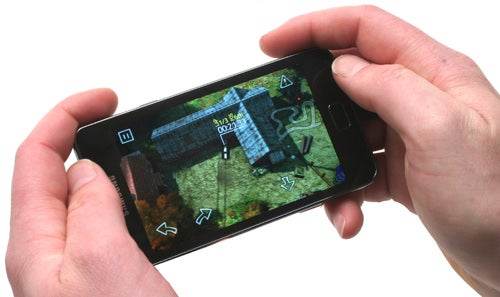
For all this extra speed, the iPhone 4 still ”feels” that bit slicker with the subtlest of graphical tricks still missing – things like the inertia of menus as you scroll through them being slightly off on the S2. This is simply a trait of Android, though, and it’s something the S2 combats better than any Android phone we’ve seen before.
The particular version of Android on show here is Android 2.3.3 Gingerbread, which isn’t quite the latest (2.3.4 adds video chat) but the Galaxy S2 suffers little because of this, and an update should come relatively soon. As usual, Samsung couldn’t resist giving the interface a bit of a visual tweak.

The most obvious change is that the main desktop/homescreen (the one the home button takes you to) is the left most one (as opposed to the middle one) with six others available off to the right and none to the left. If you swipe as though to access a screen to the left of the homescreen, it just bounces off rather than looping through to the right-most one as you’d expect.
This is downright annoying as it means you can only access one other screen within one swipe of your finger, whereas if you’re free to swipe to the left and right you can access two pages within one swipe. It may sound very picky, and indeed if you tap the tiny dots that run along the bottom of the screen you can access all the homescreens in one motion, but it’s just such a silly little usability failure. And one can’t help but think Samsung has done it simply to make the phone look/feel more like an iPhone, without thinking about the usability.
Another annoyance is the lock screen. Once you’ve activated the screen with the touch of the central home button or side power button you can unlock the phone by swiping the picture in whatever direction you want. Great! Except because there’s no visual indicator to tell you how far you need to swipe, it can take several goes for it to successfully register that you’re trying to unlock the screen, otherwise the picture simply snaps back into position.

From here on in, though, this phone is a breeze to navigate, and has a particularly good homescreen manager. Just as with other Android handsets, you can simply drag apps to and from the various homescreens or add folders of apps and widgets to them. However, Samsung has upped the usability by splitting the screen and having the homescreens presented as shrunken versions of themselves in a carousel arrangement at the top, making it easier to see where you want to place things. You can also resize widgets using a simple grab-the-corner-and-drag method. You can’t start an app folder by simply dragging one app on top of another though, as on the iPhone and Sony Ericsson’s latest Android phones.

This same visual style is also used to let you rearrange the apps in the main menu (App Launcher). While this customisation is welcome, it’s rather annoying that you can’t simply choose to have all your apps in alphabetical order, as most Android users have become used to. After all, with all those homescreens as well, having to organise the main menu just means you have two things to keep on top of.
Also of debatable benefit is the addition of ’tilt to zoom’. By holding two fingers on screen and tilting the phone back and forth you can zoom in an out of the usual selection of apps such as the picture viewer and web browser. If ever there was a feature to represent the word ‘gimmick’ in the OED, this could well be it. Thankfully you’re under no obligation to use it.
Other Samsung additions include the hubs, of which there are four: Music, Game, Readers, and Social. Music provides access to a music download service provided by 7Digital. The interface is simple but effective – so long as you know what artist you’re searching for – and the selection is extensive. Prices also seem reasonable. Most albums sell for £7.99 and tracks £0.99.
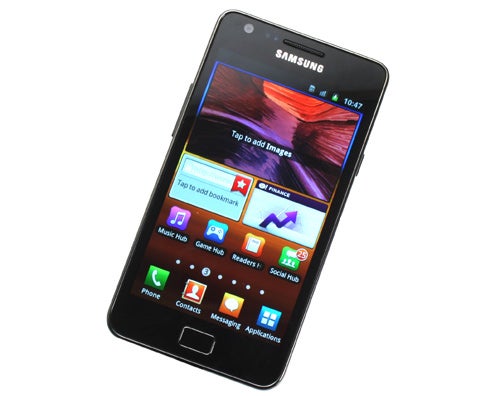
Game Hub provides access to social games powered by Mobage and not one of them even remotely captured our imagination or interest, while Premium Games can also be downloaded. These are provided by Gameloft – one of the big names in mobile gaming at the moment – with titles such as Real Football 2011, GT Racing, and Avatar. All are graphically quite impressive, though we’re yet to find one of these more ambitious 3D titles that really provides as much fun as the simpler physics-based games you’ll find in abundance on the Android Marketplace.
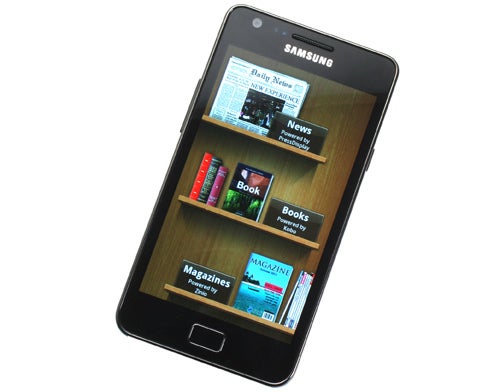
Readers Hub brings together books, magazines and newspapers via the Kobo, Zinio, and PressDisplay services. Each requires its own account but once signed up you get extensive selections of all the above and they all provide reasonably easy interfaces for finding the content you want.
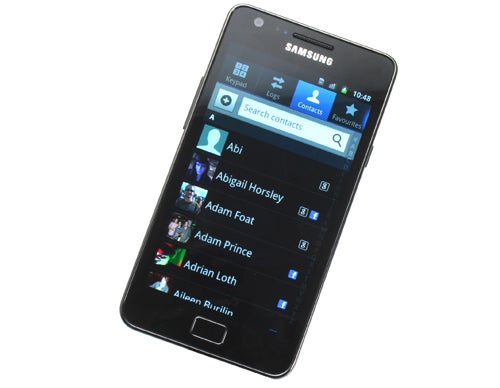
Turning to our standard tests, managing contacts and making calls on this phone is a cinch. Sign into your Gmail, Facebook and Twitter accounts and you’ll find your contacts populated with all the information therein, making it a breeze to get your phone fully synced-up with your social life. However, when it comes to calling this phone is frankly disappointing. The earpiece is too quiet, it rattles slightly when pushed to maximum volume and the speaker is also rather weedy. You get by in normal environments but a phone for all situations this is not.
Start tapping out an email or message and the excellent keyboard – helped immensely by the extra space provided by the wider screen – soon allows you to bash words out at a good pace. We did find one issue, however. When adding special characters – numbers, symbols and the like – it breaks the convention of defaulting to the number screen when you press the ‘?123’ button. Instead it remembers the last one of the three special character screens you last used. This regularly caught us out and would make us want to install an alternative keyboard.
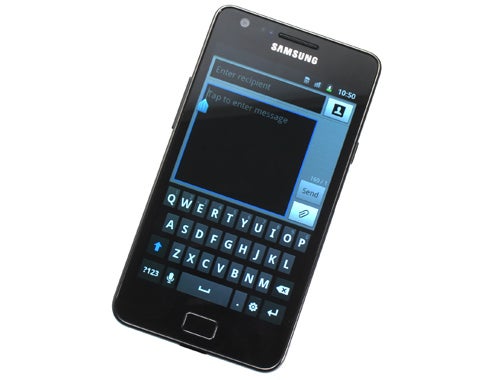
Otherwise, emailing and messaging is as excellently handled as we’d ever expect of an Android phone.
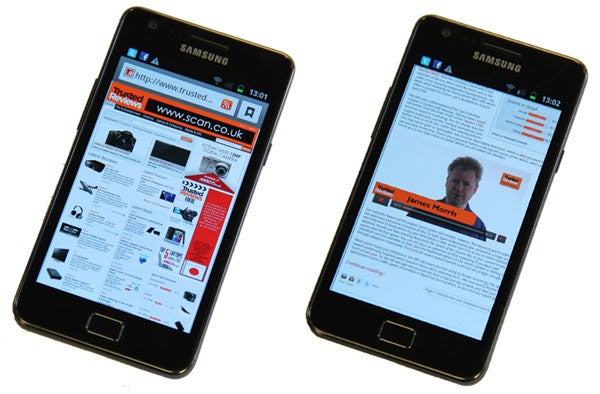
Browsing the web is a superb experience thanks to the sheer speed of the device. There are no particularly clever features, except when doubling tapping the screen to zoom in – it zooms to the size of the element you double tapped rather than a standard easy-to-read distance. This is borrowed from the iPhone. You of course get Flash support and this is one area where the extra speed of that processor really comes to the fore with videos playing back flawlessly and not bringing the handset to a standstill.
Multimedia support is also excellent with DivX, Xvid and mkv all ready to roll straight away. 720p video plays back flawlessly as well and looks simply glorious on the large screen.
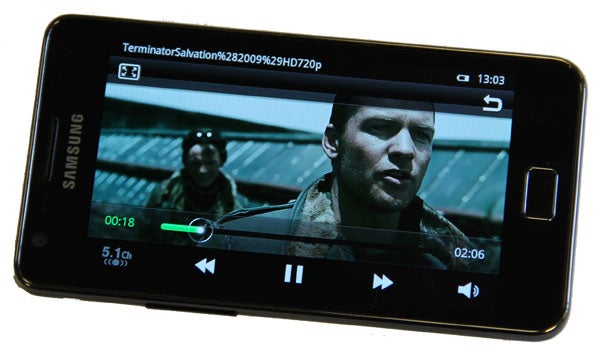
Also impressive is the camera, which can shoot 8 megapixel stills and 1080p video. The app itself is easy to use with key niceties like touch-to-focus and plenty of scene modes included. Results are noticeably better than your average 5 megapixel camera phone though as ever are still some way of dedicated compact camera quality. Nonetheless, comparing to the similarly specified LG Optimus 2X, the Samsung comes out on top. Detail in good lighting has them looking fairly even but the Samsung did a much better job of producing an evenly lit, wobble free shot with the flash and a brighter more detailed dark shot without the flash.
1080p footage is nice to have but you’re probably better off dialling it back to 720p for better performance and smaller file sizes – the lens/sensor simply aren’t good enough for the difference to be worthwhile and the higher framerate at lower resolutions makes for nicer viewing anyway. Unfortunately we kept the wrong file for our sample to upload to youtube so you’re only seeing the camera work at 480p but even here you come out with a clip that’s nice to watch with a smooth natural looking picture.
With all that power under the hood it’s no surprise that battery life isn’t this phone’s strong suit, though it doesn’t fare any worse than its high-end smartphone competition. Intensive use will kill it in a day easily but keep everything turned down to minimum and it’ll stretch for four days without too much problem. Essentially it comes down to the rule that you’ll need to charge it every other night for normal use.
”’Verdict”’
The Samsung Galaxy S2 (Samsung Galaxy SII i9100) is clearly the smartphone of choice for those who simply want the most power. Its 1.2GHz dual core processor and bold-and-brash 4.3in screen really combine well to create a truly
captivating, fast and eye-popping smartphone experience, especially if
you like watching video on the move. It’s not perfect. with call quality
being particularly poor – and we prefer our phones a bit smaller and more
ruggedly built, but nonetheless its strengths are so compelling as to
still earn a firm recommendation.



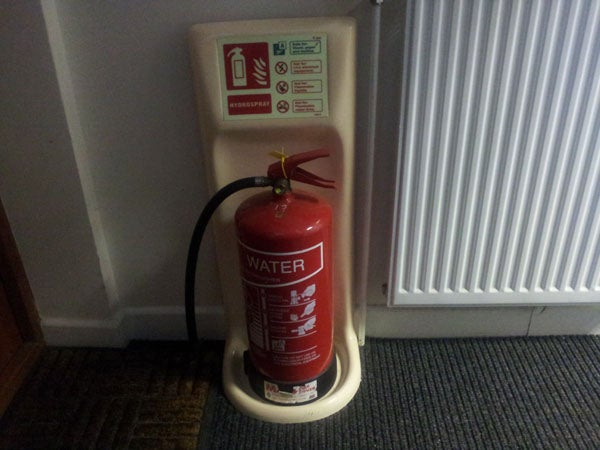
How we test phones
We test every mobile phone we review thoroughly. We use industry standard tests to compare features properly and we use the phone as our main device over the review period. We’ll always tell you what we find and we never, ever, accept money to review a product.
Trusted Score
Score in detail
-
Performance 10
-
Design 8
-
Usability 8
-
Value 8
-
Features 10
General
| Operating System | Android OS |
| Height (Millimeter) | 125.3mm |
| Width (Millimeter) | 66.1mm |
| Depth (Millimeter) | 8.5mm |
| Weight (Gram) | 116g |
| Available Colours | Black |
Display
| Screen Size (inches) (Inch) | 4.3in |
| Screen Resolution | 480 x 800 |
| Touchscreen | Yes, glass capacitive |
Battery
| Talk Time (Minute) | 710m |
| Standby Time (Hour) | 1100hr |
Storage
| Internal Storage (Gigabyte) | 16 or 32GB |
| Camera (Megapixel) | 8 Megapixel |
| Front Facing Camera (Megapixel) | 2 Megapixel |
| Camera Flash | 1 x LED |
Connectivity
| Bluetooth | Yes |
| WiFi | Yes |
| 3G/4G | Yes |
| 3.5mm Headphone Jack | Yes |
| Charging/Computer Connection | microUSB |
Processor and Internal Specs
| CPU | 1.2GHz dual-core Samsung Orion |
Misc
| App Store | Yes, 100,000+ Apps |
| GPS | Yes |

